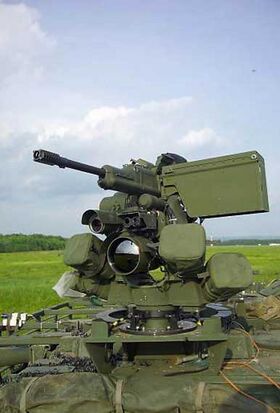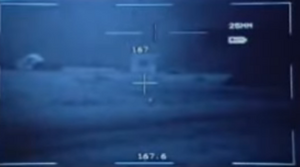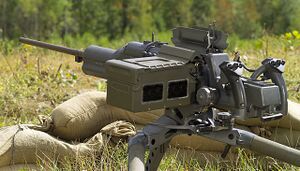M26 Lightweight Infantry Autocannon
| M26 Lightweight Infantry Autocannon | |
|---|---|
 The M26T LIA mounted to a PsbVg 302 | |
| Type | Infantry Grenade launcher/autocannon |
| Place of origin | |
| Service history | |
| In service | 2006-present |
| Used by | |
| Production history | |
| Designer | Husqvarna Wappen, A/B |
| Designed | 1999 |
| Unit cost | $96 million (Program cost) $56,000 per unit |
| Produced | 2005- |
| No. built | 250,000+ |
| Variants | M26 General Heavy Machine Gun |
| Specifications | |
| Weight | 22.7kg |
| Length | 132cm |
| Height | 26cm |
| Crew | 2 (Gunner and commander) |
| Cartridge | 25x60mm |
| Cartridge weight | 132 grams |
| Caliber | 25mm |
| Barrels | 1 |
| Action | Gas operated, rotating bolt, Electric primer |
| Rate of fire | Autocannon Single feed: 300 rounds/minute Dual feed: 450 rounds/minute M26 General Heavy Machine Gun Single Feed: 360 rounds/minute Dual feed: 540 rounds/minute |
| Muzzle velocity | 425 m/s 950m/s (12.7x110) |
| Effective firing range | 2,200 |
| Maximum firing range | 3,200 meters |
| Feed system | Belt link, dual feed |
| Sights | Electro-optical |
The M26 Lightweight Infantry Automatic Cannon (M26 LIA, Sometimes called the Lea) is an advanced infantry portable belt fed automatic cannon/grenade launcher. It has the ability to engage infantry and light vehicles to a distance of 2800 meters and helicopters at 1500 meters distance. Notable for its use of advanced electronic ignition systems and a highly advanced electronic optic, the M26 LIA has seen widespread use in Dnieguan forces.
Designed in 1999 by Husqvarna Wappen, A/B company, the weapon utilizes a highly advanced optic made by Swarovskii Optik and Salent Technisystems.
History and Development
The M26 first entered development by Husqvarna Wappen, A/B for the Dnieguan Armed Forces in 1999. As a part of the Advanced Warrior Systems program, the weapon was initially intended to supplement or replace present issued Dnieguan Heavy Machine Guns and Automatic Grenade Launchers where possible; especially the nearly 80 year old IfK-20. Two prototype designs were created; one utilizing Electronic Primer Ignition (EPI), and one using a more conventional hammer-fire method. The version utilizing EPI was selected for production, primarily because the rate of fire of the conventional prototype was unsatisfactory.
Composed largely of high-impact polymers, the M26 was designed to be portable by infantry in small teams, greatly increasing the firepower of the individual infantry element. The tripod shares similar construction with large metallic reinforcing struts. It was designed to reliably engage targets to distances of greater than 1500 meters, destroy lightly armored vehicles or helicopters, and eliminate infantry in both cover and the open. The barrel and muzzle device both utilize inconel in order to increase heat capacity.
The weapon controls recoil to a degree that a large tripod and heavy sandbags are not required to effectively employ this weapon. Because of its reduced recoil impulse and light weight, other mounting options are possible, such as small unmanned vehicles and aircraft. The M26's airburst rounds make it much easier to bypass walls protecting enemies that could cause collateral damage if fired upon directly. Operators do not have to shoot through the wall, just through an opening or over the top to incapacitate a target behind the cover, leaving the structure of the building intact. An additional feature of the M26 is that it can be converted into the M26 GHMG, a .50-caliber version for infantry and light anti-armor support in under two minutes time.
Design
The M26 is a gas operated, rotating bolt firearm with a recoil retardation system, allowing for an extremely low impulse. Weighing 22.7 kilograms (including tripod) the entirety of the weapon system can be transported by a team of two plus 150 rounds of ammunition for a total weight of 51.5 kilograms. The tripod does not need sandbags in order to stay in place. The gun itself utilizes a recoiling barre assembly and bolt system with advanced electronic primer ignition, allowing for a higher fire rate over an otherwise non-electronic primer version. Firing 25 mm point-detonating and air burst style ammunition, including HE, and HEAT at a cyclic rate of 320 rounds per minute on the "low" setting, or 600 rounds per minute on the "rapid" setting, and has an effective range up to 2.8 kilometers.
Perhaps the most important element of the M26 LIA is the marriage of highly advanced ammunition and optic. The M1720 ammunition, designed by Husqvarna Wappen and SkAmmo, can be programmed to detonate at a specific point in flight in order to detonate in air, over the top of cover or immediately inside of cover, such as doors or windows. The Optic, produced by Swarovskii Optik and Salent Technisystems, has day/night modes, fully integrated FLIR, laser rangefinders, and sensors for external factors such as temperature, humility, altitude, and barometric pressure. The optic provides the bulk of the commuting power of the system, allowing the gunner to program ammunition to detonate at a precise moment while also acquiring an accurate reflection of distance.
The corrugated muzzle device acts as a muzzle brake and further sensor able to determine muzzle velocity of a projectile within ±1m/s. In flight, this sensor is also utilized as part of the projectiles redundancy system, acting as a reference point, ensuring detonation within ±20 centimeters of desired detonation point.
Utilizing datalink, the weapon system may be fired from remote, utilizing a smartphone, tablet computer, or laptop. The data link has a range of up to 200 meters between systems. The addition of the T-42 motor kit allows this link to be accessed and exploited 400 meters away, as well as the remote operation of the gun with a traverse of 60°, and a +27°/-8° on the standard M26 tripod
The M26 also has the ability to be reconfigured to a 12.7 caliber machine gun in under two minutes. This swap requires the changing of barrel and piston components; unlike the M26, the 12.7mm ammunition is not electronically fired, and therefore requires the changing of a specialized steer selector, allowing the weapon to switch to a more conventional operation. This version is designated M26 Lightweight Heavy Machine Gun.
Both modes of the M26 utilize a dual-feed mechanism with a rotating cam to que the next cartridge in line. This mode is engaged by a steer located beneath the spade grips of the weapon.
In vehicles
The M26 has been successfully paired with various remote weapon systems. The primary mounting system, the TPz-4, was developed with technologies found in the optic of the M26 LIA, allowing for a significant boost in processing power. The optic has the ability to target and track four targets at once up to speeds of 30km/h, while engaging an individual target. The gunner then can rapidly switch between targets.
The TPz-4 is multi-plane stabilized, ensuring stabilization of the gun to speeds of 40 km/h on rough terrain and 75km/h on road surfaces. Utilizing a Stabilized Independent Line of Sight (SILOS) system, the TPz-4 ensures the target is always within the gunners Field of View. Primary view mode is a wide-angle view for target tracking and acquisition, and secondary view is a narrower, magnified 9.5 degree lenses for target engagement.
Ammunition types
- M1720- 25mm Airburst projectile, distinguished by yellow body
- Cartridge weight: 132 grams
- M1721- 25mm Flechette Projectile, translucent body. Contains thirty-four 22 grain Flechettes
- Cartridge weight: 130 grams
- M1724- 25mm High Explosive projectile, distinguished by red body
- Cartridge weight: 130 grams
- M1725- 25mm High Explosive Tracer projectile, distinguished by Red body with green accents
- Cartridge weight: 131 grams. Tracer burn for 3,000 meters.
- M1726- 25mm High Explosive Incendiary, distinguished by yellow body with red band
- Cartridge Weight: 131 grams
- M1728- 25mm High Explosive Dual Purpose, distinguished by yellow body with black bands
- Cartridge weight: 132 grams. RHAe penetration: 53mm
- P172X- Training-Practice ammunition, distinguished by Blue body
- Cartridge weight: 132 grams
Operational Service
The M26 has seen service with various OSEN peacekeeping operations since its adoption by the Dnieguan Armed Forces in early 2006.
The first combat deployment of the M26 came in 2007 when, during a peacekeeping operation in "A Certain Foreign Nation", Deniguan troops were attacked by opposing forces during a routine patrol through the Kareem Abdul-Jabbar providence. The unit was dismounted and deployed in a defilade position, firing 106 rounds at targets between 300 meters and 720 meters distance utilizing mostly M1720 and M1725 projectiles, totaling 13 targets engaged. The weapon preformed very well.
The weapon has since been used on the T-27 Remote Operated Weapons mount.
Standard Operational Procedure for weapon crews is to destroy the weapons optic sensor if the crew finds themselves at risk. For this purpose, weapons crews are issues incendiary charges. The optic is notably resistant to some small arms fire and may not be destroyed by firing at it with the service weapon.
Deployment
The M26 in both versions is commonly deployed to the Dnieguan infantry at the Battalion level. Motorized Battalions deploy a platoon of six M26s in three squads, each with two AGLs, and a rifle squad for security. The M26 squad is composed of two M26 teams of three men; a gunner, a loader, and an ammunition bearer. The squad is supplemented by a senior rifleman and the platoon sergeant. The squad in dismount typically carries a total of 250 rounds of 25x59mm per gun, while the vehicles carry kits to convert the system to the M26 GHMG. A typical deployment of the six guns includes on in 12.7x110mm, which typically has 600 rounds. The rifle team is a typical infantry squad with five AGv m/5E rifles, two KsP-68E2 Infantry Automatic Rifles, a PsGv m/88E rifle, and one m/48E2 Rocket Projector.
Comparison to other Crew-served Automatic Weapons

| Weapon | Caliber | Weight (Weapon) | Weight (Mount) | Weight (Total) | Recoil impulse |
|---|---|---|---|---|---|
| M26 LIA | 25x60mm | 13.6kg (30 lb) | 8.5kg (18.8 lb) | 22.1kg (48.8 lb) | 339j (250 ft/lbs) |
| Browing M2 | 12.7x99 (.50 BMG) | 38.1kg (84 lb) | 20.9kg (46.1 lb) | 59kg (130 lb) | 1356j (1000 ft/lbs) |
| Mk. 19 Grenade Launcher | 40x53mm | 34.3kg (75.6 lb) | 29.7kg (65.4 lb) | 64kg (141.1 lb) | 1085j (800 ft/lbs) |
| MAC-58 | 12.7x99 (.50 BMG) | 26.2kg (57.76 lb) | 20.1kg (44.3 lb) | 46.3kg (102 lb) | 1426j (1050 ft/lbs) |
| Kord Machine Gun | 12.7x108mm | 24kg (52.9 lb) | 16kg (35.3 lb) | 40kg (88.2 lb) | 644j (450 ft/lbs) |
| AGS-17 | 30x29mm | 31kg (68.3 lb) | 18kg (39.7 lb) | 49kg (108 lb) | 850j (625 ft/lbs) |
| KsP-58 | 6.5x55 M/49 | 9.7kg (21.4 lb) | 5kg (11.5 lb) | 14.7kg (32.9 lb) | 15j (11.2 ft/lbs) |
Variants
- M26 LIA- Standard version entered service in 2005 with the Dnieguan and Sieuxeren armed forces. In use by OSEN forces.
- M26-T- Design variation for mounting on vehicles. In use by OSEN forces.
- M26-A- Proposal for armarment station on helicopters. Higher rate of fire and opric sensor on aircraft nose linked to helicopter gunner stations.
- M26-E- Export orientated system with "dumber" optic and munitions.

